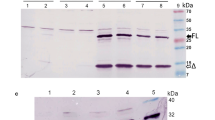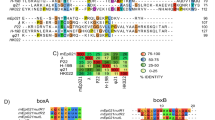Abstract
THE synthesis of the morphogenetic proteins of bacteriophage λ seems to be regulated at the post-transcriptional level. This conclusion is based on the observation that the ratio of protein to DNA along the left arm of the λ genome varies from gene to gene by as much as 870-fold (Fig. 1), while the ratio of mRNA to DNA in this region varies less than twofold1, reflecting its transcription from a single promoter as a polycistronic mRNA2–5. These large variations in the molar ratios of the morphogenetic proteins could be explained by three different control mechanisms. (1) The initiation of protein synthesis could be controlled at the level of ribosome binding either by initiation factor complexes or by mRNA secondary structure6,7. (2) Some morphogenetic proteins could act to regulate their own translation or that of neighbouring genes (N. Sternberg, personal communication). (3) The differential translation of the late gene transcripts could be achieved by selectively inactivating some transcripts but not others. Our previous experiments using RNA:DNA hybridisation ruled out differential chemical decay of the mRNA derived from the late region of the genome, but did not exclude the possibility that differential functional inactivation of morphogenetic gene transcripts could account for the late protein to DNA variation1. Recent experiments indicate that functional and chemical decay are different processes which can vary widely in rate8 and temperature dependence9. Functional decay in a polycistronic message generally seems to involve an endonucleolytic attack near the 5′-end of each gene transcript8,10 at a specific target either in or near the ribosome-binding site11. Thus mRNA inactivation is not primarily a function of the length of a transcript and can vary from transcript to transcript within the same cell11. Because of this variation, differential functional decay has been invoked as a possibly significant mechanism of post-transcriptional control11,12.
Similar content being viewed by others
References
Ray, P. N., and Pearson, M. L., J. molec. Biol., 85, 163–175 (1974).
Oda, K., Sakakibara, Y., and Tomizawa, J., Virology, 39, 901–918 (1969).
Herskowitz, I., and Signer, E. R., J. molec. Biol., 47, 545–556 (1970).
Chowdhury, D. M., Guha, A., Nature new Biol., 241, 196–198 (1973).
Gariglio, P., and Green, M. H., Virology, 53, 392–404 (1973).
Goldman, E., and Lodish, H. F., J. molec. Biol., 67, 35–47 (1972).
Groner, Y., Pollack, Y., Berissi, H., and Revel, M., Nature new Biol., 239, 16–19 (1972).
Yamada, Y., Whitaker, P. A., and Nakada, D., Nature, 248, 335–338 (1974).
Kennell, D., and Bicknell, I., J. molec. Biol., 74, 21–31 (1973).
Blundell, M., and Kennell, D., J. molec. Biol., 83, 143–161 (1974).
Blundell, M., Craig, E., and Kennell, D., Nature new Biol., 238, 46–49 (1972).
Puga, A., Borras, M., Tessman, E. S., and Tessman, I., Proc. natn. Acad. Sci. U.S.A., 70, 2171–2175 (1973).
Murialdo, H., and Siminovitch, L., in The Bacteriophage Lambda (edit. by Hershey, A. D.), 711–723 (Cold Spring Harbor Laboratory, New York, 1971).
Pato, M. L., and Von Meyenberg, K., Cold Spring Harb. Symp. quant. Biol., 35, 497–504 (1970).
Marrs, B. L., and Yanofsky, C., Nature new Biol., 234, 168–170 (1971).
Kennell, D., and Simmons, C., J. molec. Biol., 70, 451–464 (1972).
Summers, W. C., J. molec. Biol., 51, 671–678 (1970).
Craig, E., Cremer, K., and Schlessinger, D., J. molec. Biol., 71, 701–715 (1972).
Jaenish, R., Jacob, E., and Hofschneider, P. H., Nature, 227, 59–60 (1970).
Hayashi, M. N., and Hayashi, M., Proc. natn. Acad. Sci. U.S.A., 61, 1107–1114 (1968).
Walker, P. M. B., Prog. Nucleic Acid Res. molec. Biol., 9, 301–326 (1969).
Schwartz, T., Craig, E., and Kennell, D., J. molec. Biol., 54, 299–311 (1970).
Murialdo, H., and Siminovitch, L., Virology, 48, 785–823 (1972).
Hendrix, R. W., and Casjens, S. R., Proc. natn. Acad. Sci. U.S.A., 71, 1451–1455 (1974).
Bremer, H., and Yuan, D., Biochim. biophys. Acta., 169, 21–34 (1968).
Gillespie, D., and Spiegelman, S., J. molec. Biol., 12, 829–842 (1965).
Lozeron, H. A., and Szybalski, W., Virology, 39, 373–388 (1969).
Ray, P., and Murialdo, H., Virology (in the press).
Bremer, H., and Yuan, D., J. molec. Biol., 38, 163–180 (1968).
Author information
Authors and Affiliations
Rights and permissions
About this article
Cite this article
RAY, P., PEARSON, M. Functional inactivation of bacteriophage λ morphogenetic gene mRNA. Nature 253, 647–650 (1975). https://doi.org/10.1038/253647a0
Received:
Revised:
Published:
Issue Date:
DOI: https://doi.org/10.1038/253647a0
- Springer Nature Limited
This article is cited by
-
Expression of theunc genes inEscherichia coli
Journal of Bioenergetics and Biomembranes (1988)
-
Translational signals of a major head protein gene of bacteriophage lambda
Molecular and General Genetics MGG (1988)
-
A role for mRNA secondary structure in the control of translation initiation
Nature (1982)
-
Morphogenetic genes C and Nu3 overlap in bacteriophage λ
Nature (1980)





